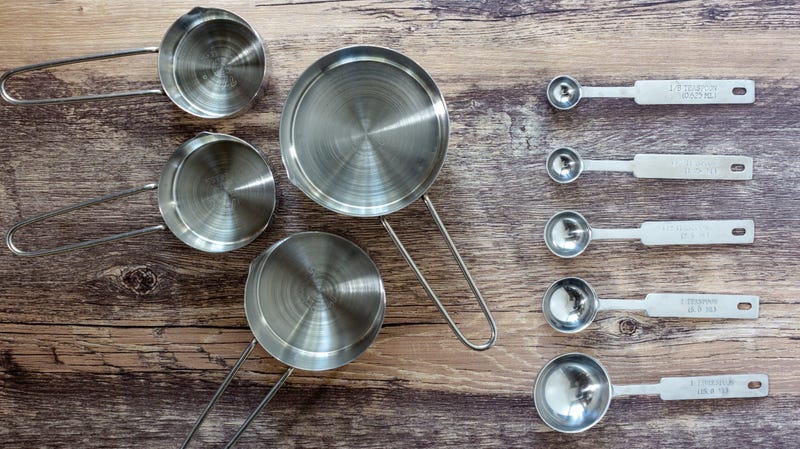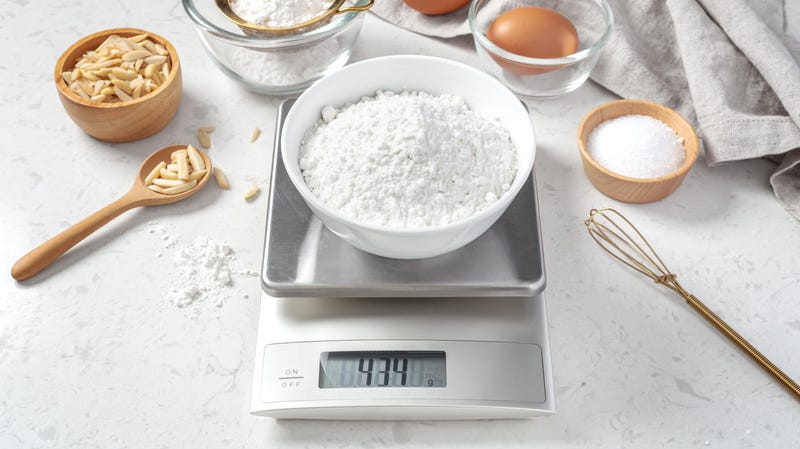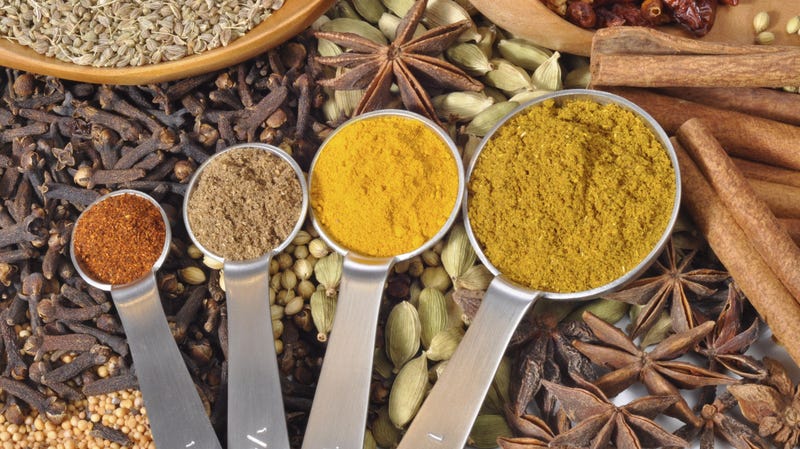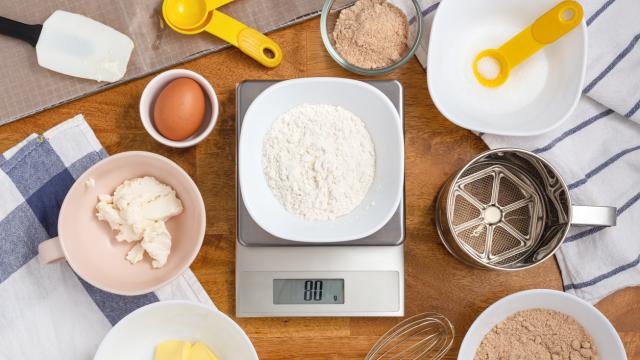Believe it or not, adding a pinch of this, a handful of that, and a dash of “the good stuff” all counts as “measuring” your food; even if the unit of measurement is unique to you. There’s nothing wrong with spontaneously exploring flavours and ingredients when whipping up a meal. That’s part of the fun. It’s when you want to duplicate a recipe over and over, or follow someone else’s recipe, that consistent measuring becomes important. Here’s how to reliably measure every ingredient in your grown-up kitchen.
When and how to measure by volume

When you measure something “by volume,” you are measuring the amount of space an ingredient takes up. Simple enough, but “cup” has two meanings in the kitchen—the short, scoop-like cups are for dry ingredients, and the taller cups with pour spouts and little lines on the side are for liquids.
Measuring cups, both wet and dry, are the most common tool for measuring by volume. Numerous recipes, especially in America, list ingredients by volume instead of by mass. If you’ve baked chocolate chip cookies or simmered up some chicken soup, you’ve measured by volume. For dry ingredients, scoop or pour the ingredient into the measuring cup until it’s full and level at the top edge. For liquids, fill to the corresponding measurement on the cup.
For flour and other ground or powdered ingredients, the recipe standard is to “spoon and level.” (Or measure by mass, but more on that later.) Use a separate spoon to scoop the flour out of the bag and into the measuring cup. Then take a straight edge, like a bench scraper or the back of a butter knife, and level off the flour at the top edge.
The reason for this extra step, and ultimately why measuring by volume is limited in scope, is particle density. A directly scooped cup of flour is more densely packed and weighs more than a spooned and leveled cup of flour. When you spoon and level, you incorporate air into the four, so less flour takes up the same amount of space. Think of the difference between brown sugar dropped into a cup, compared to when you compress that brown sugar. If you directly scoop your flour, your recipes might be drier or tougher than they’re meant to be.
How to buy measuring cups
Make no mistake, I have dry and wet measuring cups and I use them. If I’m working with a recipe that’s measured in cups, I use the spoon and level method for anything powdered, and things turn out dandy. For best results, choose dry measuring cups that have a clearly defined edge for easy leveling. Handmade ceramic measuring cups that look like elephants or lemons are adorable, but you’ll never get a clean level over that trunk. I like stainless steel cups for their sharp edge, as well as the fact that they don’t hang onto odors, or scratch like plastic cups, and they’re easy to clean.
For wet measuring cups, I like PYREX (not pyrex), because it is made with borosilicate glass, so you can use it to measure hot liquids, or put one in the microwave to melt and measure butter or chocolate, and they’re easy to clean. Whichever brand you choose, look on both sides of the cup. You want one that measures in cups, ounces, and millilitres.
Volume will get you pretty far, but if you fall in love with a recipe and want to duplicate it forevermore—or want to get really into baking—you’ll be better off converting the measurements to grams and documenting the mass for the most consistent results every time.
When and how to measure by mass

I transitioned to weighing ingredients once I started baking professionally, but more and more home cooks are pivoting towards the humble kitchen scale. They’re small, affordable, accessible, electronic, and easy to use. These are exciting times for home cooks, but also for the metric system (in the United States, at least).
Weighing ingredients tells you how much of the actual ingredient is on the scale. Grain size, how much air is mixed in, or how compressed the item is won’t change its mass. If you put an egg white on the scale, and then whip the egg white to twice its volume, you’ll still have the same mass of egg white—at least theoretically; some egg white might stay on the whisk.
Weighing ingredients is as accurate and consistent as your scale. Most of them are pretty darn accurate, and mass is much harder to argue with than volume. But you don’t have to take my word for it. Once you get a kitchen scale, weigh a cup of flour that’s been scooped and a cup that’s been spooned and leveled. The difference can be surprising. Click the scale over to measure grams and weigh a tablespoon of fine table salt and a tablespoon of chunky kosher salt. If you’re making bread, your salt measurement could mean life or death (for the yeast).
After that fun is over, explore the functions. Jump back and forth between grams, ounces, and pounds. Definitely take advantage of the “tare” function. Taring, sometimes called “zero-ing out,” brings the scale back to zero regardless of what’s sitting on the scale. That lets you measure everything in one bowl. Measure the flour, tare back to zero, measure the sugar, tare, measure the butter. No more need for separate bowls.
The scale is a baker’s best friend, but you don’t have to be oven-obsessed to appreciate the kitchen scale. Use it to measure out portions of pasta (two ounces isn’t what you think it is), weigh your hamburger meat to make identical patties, or use it to weigh your food for weekly meal prep.
When and how to measure the strong stuff

There are times when measuring by weight isn’t the most practical, like with seasonings, spices, or other ingredients where a little goes a long way–the strong stuff.
Use measuring spoons to measure things like dried and fresh herbs, dry spices, hot sauce, chili flakes, salt, ground peppers, citrus zest and juice, and extracts. Most kitchen scales are only sensitive to a point. Unless you have some sort of chemist’s scale (and you won’t), you’re better off with tiny spoons. Once you get down to the difference between a gram or two, your scale might not detect small additions until there’s a more significant weight change, and that could result in an over-spiced or over-leavened dish.
When measuring powders, you’ll want to level off the top of the spoon, so look for a set that has a sharp top edge. Stainless steel will be your best bet for something sturdy and practical. The classic design features a round spoon, but the tablespoon size is often too big for most spice jars. Instead, look for oblong or rectangular spoons, like the ones I listed above. Outfit your kitchen with these four types of tools and you’ll be ready to take on any recipe.
Lead Image: iStock

Leave a Reply
You must be logged in to post a comment.